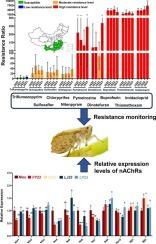2020-2023年中国褐飞虱抗药性的全区调查与监测
IF 4.2
1区 农林科学
Q2 BIOCHEMISTRY & MOLECULAR BIOLOGY
引用次数: 0
摘要
褐飞虱 Nilaparvata lugens (Stål) 是影响亚洲水稻作物的一种臭名昭著的害虫。褐飞虱对杀虫剂产生抗药性是有效防治该害虫的一大挑战。本研究揭示了 2020 年至 2023 年中国十个省份和上海市 BPH 对九种杀虫剂的抗药性状况。监测结果表明,BPH对三氟嘧啶胺、硝螨酯和敌稗的抗性迅速增加。前列腺增生症对嘧菌酯的平均抗性从 2.5 倍增加到 7.1 倍,对吡蚜酮的平均抗性从 18.3 倍增加到 37.7 倍,对硝基呋喃丹的平均抗性从 119.5 倍增加到 268.1 倍。所有种群对吡虫啉、噻虫嗪和丁硫克百威的抗性仍然极高。大多数 BPH 田间种群对毒死蜱和磺胺二甲嘧啶保持中度抗性,对吡蚜酮保持高度抗性。然而,考虑到吡蚜酮具有抑制繁殖的特性,用杀虫剂抗性行动委员会(IRAC)NO.005 方法监测到了吡蚜酮的易感抗性至低抗性水平。这一结果表明,吡蚜酮可能会失去对施药世代的防治效果,但它能显著抑制牛肝菌田间种群的繁殖。此外,我们还比较了 11 个烟碱乙酰胆碱受体(nAChR)基因(nAChR 竞争性调节剂的靶标)在四个田间种群(FY23、YH23、LJ23、LP23)和易感株中的表达水平。在所有田间种群中,nAChR α4的表达水平都显著降低,而在α1、α2、α6和α7中,一些田间种群的表达水平也显著降低。我们的研究结果为 N. lugens 的抗性管理策略提供了有价值的信息,并为 nAChR 竞争性调节剂的抗性机理提供了新的见解。本文章由计算机程序翻译,如有差异,请以英文原文为准。

Area-wide survey and monitoring of insecticide resistance in the brown planthopper, Nilaparvata lugens (Stål), from 2020 to 2023 in China
The brown planthopper (BPH), Nilaparvata lugens (Stål), is a notorious pest affecting Asian rice crops. The evolution of insecticide resistance in BPH has emerged as a significant challenge in effectively managing this pest. This study revealed the resistance status of BPH to nine insecticides in ten provinces and Shanghai City in China from 2020 to 2023. Monitoring results showed that the resistance of BPH to triflumezopyrim, nitenpyram, and dinotefuran increased rapidly. The average resistance ratio of BPH to triflumezopyrim increased from 2.5 to 7.1 fold, nitenpyram from 18.3 to 37.7 fold, and dinotefuran from 119.5 to 268.1 fold. All populations remained extremely high resistance to imidacloprid, thiamethoxam, and buprofezin. Most field populations of BPH maintained moderate resistance to chlorpyrifos and sulfoxaflor, and high resistance to pymetrozine by rice stem dipping method. However, considering the reproduction-inhibiting character of pymetrozine, susceptible to low resistance levels to pymetrozine were monitored by Insecticide Resistance Action Committee (IRAC) NO.005 method. This result indicated that pymetrozine might lose efficacy in the control of application generation, but it could significantly inhibit the reproduction of field populations of BPH. Additionally, we compared the expression levels of 11 nicotinic acetylcholine receptor (nAChR) genes, the targets of nAChR competitive modulators, in four field populations (FY23, YH23, LJ23, LP23) and susceptible strain. The expression level of nAChR α4 was significantly reduced in all field populations, while α1, α2, α6, and α7 were significantly reduced in some field populations. Our findings provide valuable information for resistance management strategies in N. lugens and offer new insights into the resistance mechanisms of nAChR competitive modulators.
求助全文
通过发布文献求助,成功后即可免费获取论文全文。
去求助
来源期刊
CiteScore
7.00
自引率
8.50%
发文量
238
审稿时长
4.2 months
期刊介绍:
Pesticide Biochemistry and Physiology publishes original scientific articles pertaining to the mode of action of plant protection agents such as insecticides, fungicides, herbicides, and similar compounds, including nonlethal pest control agents, biosynthesis of pheromones, hormones, and plant resistance agents. Manuscripts may include a biochemical, physiological, or molecular study for an understanding of comparative toxicology or selective toxicity of both target and nontarget organisms. Particular interest will be given to studies on the molecular biology of pest control, toxicology, and pesticide resistance.
Research Areas Emphasized Include the Biochemistry and Physiology of:
• Comparative toxicity
• Mode of action
• Pathophysiology
• Plant growth regulators
• Resistance
• Other effects of pesticides on both parasites and hosts.

 求助内容:
求助内容: 应助结果提醒方式:
应助结果提醒方式:


